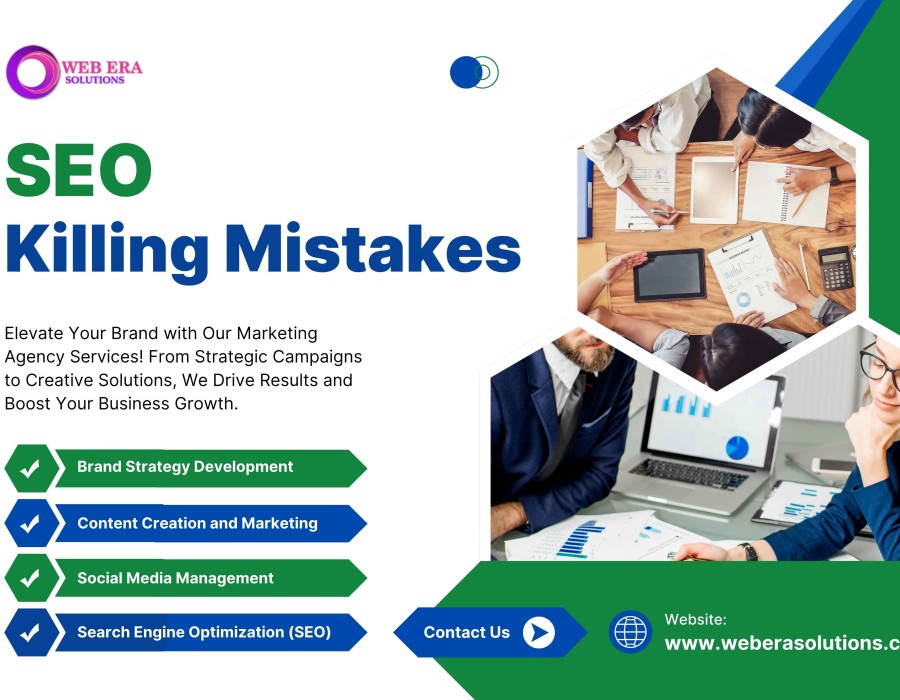In this digital era, having a nice website is only half the equation; it should be optimized for search engines to drive organic traffic and help customers improve their rankings on Google. Many brands make investments in the web development services process and don't even realize they are making SEO mistakes which undermine their overall SEO strategy. If your goal is to improve your online presence, you will want to steer clear from these common web development mistakes.
Web Era Solutions is an SEO agency dedicated to making SEO-friendly websites that look great and perform well in the SERPs. Continue reading for the 10 website development mistakes that will hurt your SEO and how to fix them.
1. Ignoring Mobile Responsiveness
Over 50% of internet traffic is now mobile, and Google loves mobile-friendly sites. What that means is if your site isn’t responsive, the people visiting you on their mobiles are likely to bounce more and contribute less traffic overall.
Solution: Make sure you are always designing responsively for all the devices your visitors might be using on your site. You can confirm whether your website is optimized for mobile by running Google’s Mobile-Friendly Test.
2. Slow Page Loading Speed
Users leave websites that take longer than 3 seconds to load. Search engines view page speed as a direct ranking factor (some search engines do not take other additional page load factors into an account). This means that if your website is slow to load, it is going to be a struggle to rank it higher.
Assessment: Improve performance by optimizing images, particularly for the Internet; using either a CDN (content delivery network) or your own web server to deliver images to users; and enabling the browser to cache static files. Improve performance by compressing CSS files, JavaScript files, and HTML files.
3. Poor Website Architecture
Having a formal, complex, or unstructured on-site structure prevents search engines and bots from crawling and indexing pages accurately. It can also confuse users, which is not good for user experience.
4. Missing or Duplicate Meta Tags
Page titles and descriptions are really important for CTRs and rankings. If tags are missing, replicated or not written well it will limit visibility within search results substantially.
5. Not Using HTTPS
Google prioritizes secure sites. A site that is unsecure (HTTP) provides 1) a negative impact on your SEO, and 2) a lack of trust from your users.
Solution: SSL certificate installation and having all pages served securely with HTTPS. Redirect old HTTP URLs to new HTTPS URLs.
6. Broken Links and 404 Errors
And broken links – both internally and externally can not only be annoying to the user but also are harmful for your search engine traffic. Bag Hire Bad Links refer to broken links – so if your site has bad links, it means that the website is not in a good shape.
You should conduct a broken link audit of your website on a regular basis; you can do a site audit for broken links with the help of online broken link checkers like screaming Frog and Ahrefs. Either repair broken pages or take it a step further and redirect those in some way to a related page of your site.
7. Overusing JavaScript
JavaScript can provide functionality but can be used excessively and stop search engines from crawling and indexing your site correctly. This limits your site's visibility for its important content.
The resolution is to ensure your key content is accessible in HTML, or server-side-rendered or pre-rendered, if you are heavily dependent on javascript.
8. Neglecting Image Optimization
Utilizing high-resolution, uncompressed images can hinder your loading speed, as well as your SEO for that matter. Notably, when you have a photo that does not use any alt tag information, search engines (including Google) have no clue what the image is or what it is showing.
Solution: Reduce your images to a smaller file size while still keeping decent quality, and add alt tags to all images that accurately describe the image and use the project key phrase(s) for higher ranking. The latest image types, such as WebP, are so efficient they will decrease loading time.
9. Lack of Structured Data (Schema Markup)
Structured data can yield rich results (ratings, FAQs, breadcrumbs, etc.) in search engine results pages (SERPs) and make it easier for the search engine to interpret your material. If you do not implement structured data you will lose the added exposure, and real estate in SERP's.
Recommendation: Use schema markup that is relevant to your business such as LocalBusiness schema, Product schema, or Article schema and test your structured data implementations with Google's Structured Data Testing Tool.
10. Poor Internal Linking
Internal links assist with navigation throughout your site, letting both spiders and people know your content hierarchy. If a well-planned internal linking structure does not exist, you cannot expect your pages to rank, and users may leave before they explore your site.
Solution: Connect relevant content on your site with a keyword-rich anchor text. Again, ensure that you factor your key pages to get more internal links to show relevance and authority.
Your website is the bedrock of your online success, but small web development mistakes can severely hurt your SEO. When you avoid these 10 common web development mistakes, you’ll be all set to build your website that looks professional but also ranks highly in search engines.
At Web Era Solutions, we build SEO-optimized websites that drive traffic, generate leads, and grow your business. Our company can assist you with fixing SEO errors on your current website or creating a whole new one.
🚀 Ready to Boost Your Website’s SEO?
Don’t let web development errors hold back your business. For results-driven, expert web design, web development, and SEO services, collaborate with Web Era Solutions.
👉 Contact us today to create a high-performing, SEO-friendly website for your business!





Comments